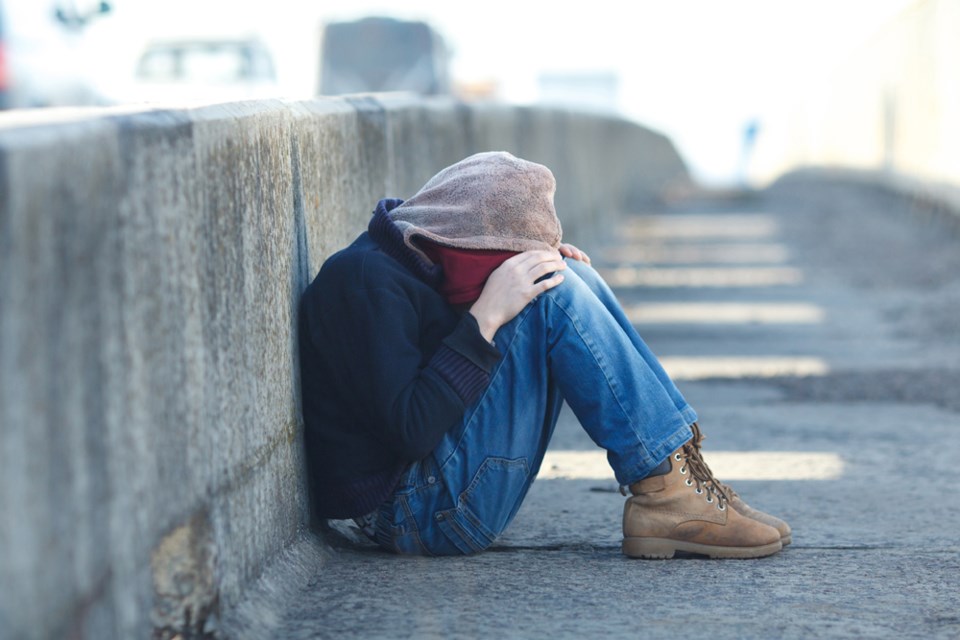Burnaby’s homeless population increased by 19 per cent over the last three years, according to preliminary findings from the 2017 homeless count.
Volunteers counted 69 homeless people on March 8, up from 58 in 2014.
The report, released on Monday, defines homeless as not having a place to stay for more than 30 days, and not paying rent.
The 24-hour snapshot showed that 49 of the 69 homeless in Burnaby were unsheltered, meaning they were living outside, including in alleys, doorways, parkades, parks and in cars.
Given the freezing temperatures on the evening of the count and no permanent homeless shelter in the city, 19 homeless people said they were staying at an emergency facility. Lookout Society’s extreme weather shelter at Westminster Bible Chapel opened for 76 nights during the 2016/17 season and recorded 709 stays.
The findings also show Burnaby’s homeless population includes 12 unsheltered and five sheltered children and youth under the age of 25.
“It’s a crisis that can’t be ignored,” said Wanda Mulholland, organizer of the Burnaby count and coordinator of the Society to End Homelessness in Burnaby. “People need housing. The United Nations talks about housing as a basic human right.”
Data not included in the report, but just as important, is the number of people who have died as a result of homelessness and long-term poverty, according to Mulholland.
She told the NOW since the last count in 2014 (they happen every three years), 24 Burnaby citizens have died, with 15 in the last year. Forty-five have died since 2006.
“This is not a stagnant situation. People are in and out of homelessness,” she said, noting the average age at the time of death is 42.
Mulholland said all three levels of government need to work together on this file.
“It’s about the collaboration that makes things happen, that provides for people in a way that is respectful,” she said.
Mulholland added having a permanent shelter in Burnaby would be an important part for some people living on the streets.
“Some people don’t have any other issue other than they can’t afford to live here anymore, but for some, a shelter, staff resources are very important,” she said.
Meanwhile, Mayor Derek Corrigan called Monday’s findings “frustrating.”
Asked if he thought there was a correlation between Burnaby’s 69 homeless and the higher number of homeless people in neighbouring cities like New Westminster (133), the mayor said no.
“I think that mostly it is statistical anomalies whether people are going to one community or another. There’s a disproportionate amount of homeless people that have arrived in Maple Ridge, for instance, and I can’t get my head around that,” he said.
Corrigan agreed with Mulholland that all three levels of government need to work together. He pointed to the city’s 200 non-market housing units that were approved recently and made available through density bonus money.
“If there’s no one on the other side, picking up those opportunities, it’s very frustrating. What you’ll find when you talk to mayors around the region is all of us are suffering the same way. That we keep looking to be a solution, but without partners that are coming to the table at the senior levels of governments, you just don’t seem to get results,” said Corrigan.
As for having a homeless shelter in the city, the mayor reiterated that such a facility is not a solution, and what is needed is transitional shelters, “...where people are going to move through a shelter into permanent housing, and that they’re going to get treatment for the issues they’re suffering – the drug addiction or the mental illness.
“Wanda’s view is that you just give them a place to stay overnight and send them back onto the street. I think that’s fundamentally wrong, and I don’t think it’s ever going to give people any dignity,” he said.
The full report on the homeless count will come out later this year. It will provide information on how long people have been homeless, health issues and sources of income.
By the numbers
·Across Metro Vancouver, 3,605 people were identified as homeless (of those, 1,032 were unsheltered and 2,573 were sheltered). That is the highest number to date and is a 30 per cent increase when compared to 2014.
·Among the sheltered, 256 individuals stayed in extreme weather response (EWR) shelters due to inclement weather. This is the first time EWR clients have been counted.
·Thirty-four per cent identified as aboriginal, 23 per cent were seniors and 16 per cent of respondents were under the age of 25.
·The cities with the highest homeless populations were Vancouver( 2,138), Surrey (602) and Langley (206).
·In Burnaby 105 volunteers helped with the count. The teams covered 42 shifts and attended 43 sites over the 24-hour period.



